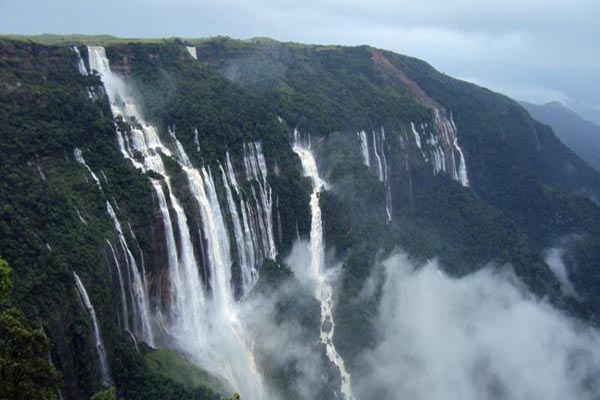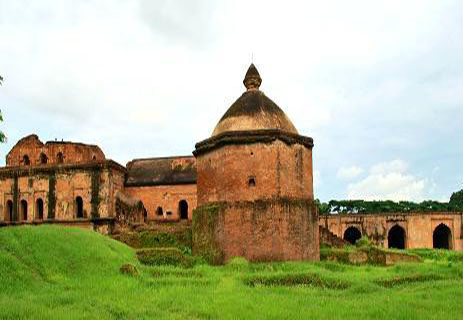
-
The Kamakhya Temple; is a Hindu temple dedicated to the mother goddess Kamakhya. It is one of the oldest of the 51 Shakti Pithas. Situated on the Nilachal Hill in western part of Guwahati city in Assam, India. It is an important pilgrimage destination for Hindu and especially for Tantric worshipers.
-
Umananda Devaloi is a Shiva temple located at the Peacock Island in the middle of river Brahmaputra just opposite the office of the Deputy Commissioner of Kamrup or the Kachari Ghat in Guwahati.
-
The Assam State Zoo cum Botanical Garden (popularly known as Guwahati Zoo) is the largest of its kind in the North East region and it is spread across 432 acre (175 hectare). The zoo is located within the Hengrabari Reserved Forest at Guwahati, India. The zoo is home to about 895 animals, birds and reptiles representing almost 113 species of animals and birds from around the world.
-
Srimanta Sankaradev Kalakshetra commonly known as Kalakshetra is a cultural institution in the Panjabari area of Guwahati, Assam, named after the medieval poet-playwright and reformer Srimanta Sankardev. It includes a cultural museum, library and various facilities for preserving, demonstrating and performing cultural items, besides a children's park.
-
The Assam State Museum is located in the southern end of Dighali Pukhuri tank which is in the heart of Guwahati city, Assam. The Museum was established by the Kamarupa Anusandhan Samiti in 1940. Assam State Museum surpasses all the other museums in India, as one of the biggest multipurpose museum.
-
Kaziranga National Park is located in the Golaghat and Nagaon districts of the state of Assam. Kaziranga is a vast expanse of tall elephant grass, marshland, and dense tropical moist broadleaf forests, criss-crossed by four major rivers, including the Brahmaputra, and the park includes numerous small bodies of water. The National Park, which hosts two-thirds of the world's great one-horned rhinoceroses, is a World Heritage Site
-
Manas National Park is a national park is a UNESCO Natural World Heritage site, a Project Tiger reserve, an elephant reserve and a biosphere reserve in Assam, India.
The park is known for its rare and endangered endemic wildlife such as the Assam roofed turtle, hispid hare, golden langur and pygmy hog. Manas is famous for its population of the wild water buffalo.
-
Pobitora wild life sanctuary, (40 km from home stay): Pobitora Wildlife Sanctuary is a wildlife reserve in the Morigaon district of the state of Assam in India. It is located about 40 km east of Guwahati. The Pobitora Wildlife Sanctuary is mainly famous for its great Indian One-horned rhinoceros. Besides rhinoceros, the other animals are leopard, wild boar, Barking deer, wild buffalo etc.
-
Deepor beel bird sanctuary (1 km from home stay). It is a permanent freshwater lake, in a former channel of the Brahmaputra River, to the south of the main river. Being only Ramsar site (List of wetlands of international importance as defined by the Ramsar Convention) of Assam Dipor Bil (also spelt as Deepor Beel It is also Considered as one of the largest beels in the Brahmaputra valley of Lower Assam.
-
Chakrashila Wildlife Sanctuary is a wildlife sanctuary falling under Dhubri and Kokrajhar districts of Assam, India. It is famous for the golden langur and is the second protected habitat for golden langur in India.
-
Assam Tea is a black tea named after the region of its production, Assam, in India. It is also traditionally used in Yunnan province in China. Assam tea is manufactured specifically from the plant Camellia sinensis var. assamica (Masters). This tea, most of which is grown at or near sea level, is known for its body, briskness, malty flavour, and strong, bright colour. Assam teas, or blends containing Assam, are often sold as "breakfast" teas.
-
Cherrapunji is credited as being the wettest place on Earth, but nearby Mawsynram currently holds that distinction. Cherrapunji still holds the all-time record for the most rainfall in a calendar month and in a year, however: it received 9,300 millimetres (370 in; 30.5 ft) in July 1861 and 26,461 millimetres (1,041.8 in; 86.814 ft) between 1 August 1860 and 31 July 1861.
-
Tawang is a mountain town in Asia. India considers it to be part of the state of Arunachal Pradesh, while China claims it as part of South Tibet. It’s home to the 17th-century Tawang Monastery, a hilltop structure housing a massive gilded Buddha statue. The War Memorial commemorates soldiers who died in the 1962 Chinese-Indian War. Nearby, tranquil Penga Teng Tso (P. T. Tso) Lake attracts migratory birds in summer.
-
Kareng Ghar, also known as The Garhgaon Palace, is located in Garhgaon, 15 kilometres from present-day Sivasagar, in Upper Assam, India. Of all Ahom ruins, the Kareng Ghar is one of the grandest examples of Ahom architecture.
-
The Rang Ghar is a two-storied building which once served as the royal sports-pavilion where Ahom kings and nobles were spectators at games like buffalo fights and other sports at Rupahi Pathar
-
Sivasagar Sivadol is a group of structures comprising three Hindu temples of Sivadol, Visnudol and Devidol, other shrines, and a museum. These are located on the banks of the Sivasagar tank, also known as the Borpukhuri tank, in the heart of Sivasagar, in the Indian state of Assam.
-
The Talatal Ghar is located in Rangpur, 4 km from present-day Sivasagar, in Upper Assam. Of all Ahom ruins, it is one of the grandest examples of Tai Ahom architecture.




















